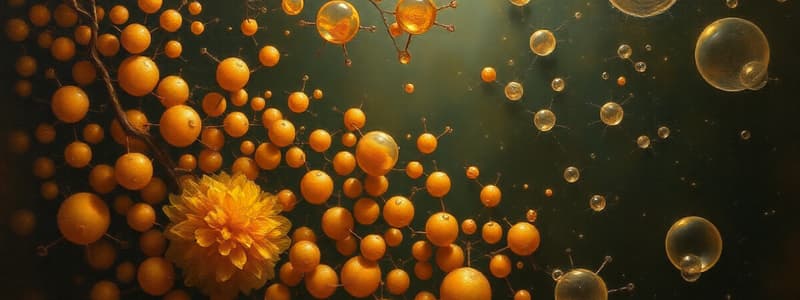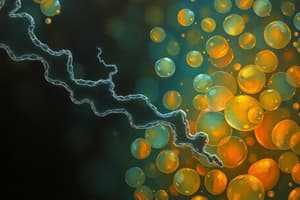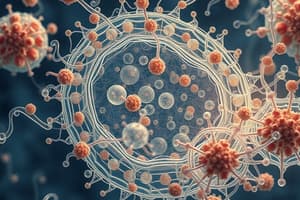Podcast
Questions and Answers
What is a key characteristic of intracellular accumulations?
What is a key characteristic of intracellular accumulations?
- They are reversible under all conditions.
- They result from excessive intake, defective transport, or defective catabolism. (correct)
- They are exclusively found in fatty tissues.
- They only occur in response to infectious agents.
Which of the following is NOT a factor contributing to cellular aging?
Which of the following is NOT a factor contributing to cellular aging?
- Reduced capacity to divide.
- Reduced ability to repair damaged RNA. (correct)
- Accumulating genetic cellular damage.
- Defective protein homeostasis.
What defines reversible cell injury?
What defines reversible cell injury?
- It is characterized by mild, transient changes. (correct)
- It is always associated with necrosis.
- It leads to complete cell death immediately.
- It occurs in response to severe, progressive stress.
Which type of intracellular accumulation is associated with atherosclerosis?
Which type of intracellular accumulation is associated with atherosclerosis?
Which of the following changes is characteristic of cellular aging?
Which of the following changes is characteristic of cellular aging?
What is a common characteristic of irreversible cell injury?
What is a common characteristic of irreversible cell injury?
What does the term 'aging pigment' refer to?
What does the term 'aging pigment' refer to?
How does metabolic disturbance affect cell morphology?
How does metabolic disturbance affect cell morphology?
What change in cellular makeup is primarily observed during hypertrophy?
What change in cellular makeup is primarily observed during hypertrophy?
Which mechanism characterizes the process of autophagy in cellular aging?
Which mechanism characterizes the process of autophagy in cellular aging?
What defines the condition of atrophy in cells?
What defines the condition of atrophy in cells?
What is a key characteristic of necrosis compared to apoptosis?
What is a key characteristic of necrosis compared to apoptosis?
What morphological change is indicative of irreversible cell injury through necrosis?
What morphological change is indicative of irreversible cell injury through necrosis?
During which cellular adaptation do cells change from one differentiated type to another due to chronic irritation?
During which cellular adaptation do cells change from one differentiated type to another due to chronic irritation?
Which of the following conditions results from hormonal stimulation and involves an increase in the number of cells?
Which of the following conditions results from hormonal stimulation and involves an increase in the number of cells?
Study Notes
Intracellular Accumulations
- Result from metabolic disturbances leading to abnormal material buildup within cells.
- Can occur due to excessive intake, defective transport, or defective catabolism.
- Triglycerides: Accumulate in cells during conditions like fatty liver.
- Cholesterol: Accumulates in macrophages and smooth muscle cells of vessel walls in atherosclerosis.
- Proteins: Immunoglobulins accumulate in plasma cells during immune responses.
- Glycogen: Accumulates in liver and muscle in glycogen storage diseases.
- Pigments:
- Exogenous:
- Carbon (anthracosis)
- Lipofuscin (aging pigment)
- Iron (in hemosiderosis)
- Endogenous:
- Lipofuscin (aging pigment) is found in liver and other cells.
- Iron (in hemosiderosis) is found in liver and other cells.
- Exogenous:
Cellular Aging
- Refers to the morphological and functional changes that occur in cells due to their prolonged lifespan
- Several contributing factors:
- Accumulating genetic cellular damage.
- Reduced ability to repair damaged DNA.
- Reduced capacity to divide (senescence).
- Defective protein homeostasis.
- Effect of high caloric intake.
- Morphological changes:
- Abnormal shaped nuclei, mitochondria, Golgi apparatus.
- Decreased endoplasmic reticulum, ribosomes.
- Accumulation of cytoplasmic lipofuscin pigment (aging pigment).
- Examples:
- Lipofuscin in neurons
- Lipofuscin in Cardiac Muscle
- Autophagy:
- Main mechanism of cellular aging.
- Involves engulfing cell organelles into cytoplasmic vacuoles, which fuse with lysosomes for digestion.
- Also occurs in cancers.
Cellular Adaptations
- Cells adapt to stress to maintain homeostasis.
- Hypertrophy:
- Increased cell size and organ size.
- Occurs in response to increased workload or growth.
- Example: Hypertrophy of smooth muscle cells of the uterus during pregnancy.
- Hyperplasia:
- Increased cell numbers.
- Driven by hormonal and growth factor stimulation.
- Occurs in tissues with dividing cells or tissue stem cells.
- Example: Hormonal hyperplasia of the female breast during puberty.
- Atrophy:
- Decreased cell size and organ size.
- Results from decreased nutrient and blood supply or disuse.
- Mechanism involves decreased synthesis of cellular proteins and organelles and increased breakdown.
- Example: Senile brain atrophy.
- Metaplasia:
- Replacement of one differentiated cell type by another differentiated cell type of the same category (e.g., epithelium to another epithelium).
- Often occurs in response to chronic irritation.
- Allows cells to better resist the stress.
- Example: Squamous metaplasia of respiratory epithelium in cigarette smokers.
Reversible Cell Injury
- Includes:
- Cellular swelling (cloudy swelling; hydropic degeneration): Intracellular accumulation of water. Example: Kidney tubules lining epithelium.
- Fatty change: Intracellular accumulation of fat. Example: Hepatocytes.
- Morphology:
- Cell swelling.
- Cell membrane blebs.
- Mitochondrial swelling.
- Swelling of the endoplasmic reticulum.
- Cells maintain their shape and can return to normal after injury.
Irreversible Cell Injury
- Necrosis:
- Death of a group of cells or tissues.
- Morphology:
- Dead cells and tissue become more eosinophilic.
- Nuclear dissolution.
- Breakdown of plasma membrane and organelle membranes forming myelin figures.
- Enzymatic digestion of cellular contents.
- Surrounding inflammation.
- Apoptosis:
- Programmed single-cell death.
- Removes unwanted or genetically damaged cells.
- Mechanism:
- Activation of cellular enzymes called 'caspases'.
- Cell fragmentation into apoptotic bodies (nuclear fragments + cytoplasm).
- Engulfment of fragmented cells by phagocytes.
- Pathways:
- Intrinsic pathway: triggered by stress or DNA damage.
- Extrinsic pathway: triggered by death receptors on cell surface.
Studying That Suits You
Use AI to generate personalized quizzes and flashcards to suit your learning preferences.
Related Documents
Description
This quiz covers the types of intracellular accumulations due to metabolic disturbances, including triglycerides, cholesterol, proteins, glycogen, and pigments. Additionally, it addresses the concept of cellular aging, highlighting morphological and functional changes in cells over time. Test your knowledge on these key pathological processes!




